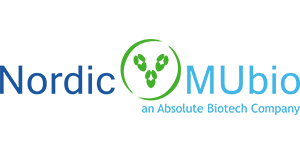Mouse anti Human vitronectin receptor CD51
Mouse anti Human vitronectin receptor CD51, IgG1, Clone: NKI-M7 (former AMF7)
SKU
NORMUB2011P
Packaging Unit
0,1 mg
Manufacturer
Nordic-MUbio
Availability:
loading...
Price is loading...
Clone: NKI-M7 (former AMF7)
Background: CD51 (Cluster of Differentiation 51), known as vitronectin receptor α chain, or integrin αV is a type I integral membrane glycoprotein. CD51 forms a heterodimer with integrin β1 (CD29), β3 (CD61), β5, β6, or β8. CD51 contains two disulfide-linked subunits of 125 kD and 24 kD. Many extracellular matrix proteins with RGD-motifs are CD51 ligands. In association with its β chains, CD51 binds vitronectin, von Willebrand factor, fibronectin, thrombospondin, osteopontin, fibrinogen, and laminin. CD51, as an adhesion molecule, plays important roles in leukocytes homing and rolling, mediates bone absorption and angiogenesis. CD51 is expressed on endothelial cells, fibroblasts, macrophages, platelets, osteoclasts, neuroblastoma, melanoma, and hepatoma cells.
Source: NKI-M7 is a Mouse monoclonal IgG1 antibody derived by fusion of SP2/0 Mouse myeloma cells with spleen cells from a BALB/c Mouse immunized with cultured melanoma cells derived from a Human melanoma metastasis.
Specificity: T-lymphocyte clones NKI-M7 detect a melanoma-associated proteoglycan (MW greater than 450-250 kDa) and a molecular complex, which under reducing conditions consists of 4 compounds of 120, 95, 29 and 25 kDa respectively. NKI-M7 reacts with cultured melanomas melanomas in frozen sections. The antigen detected by NKI-M7 is strongly associated with the adhesion and cytoplasmic spreading of melanoma cells to plastic surfaces and monolayers of vascular endothelial cells. NKI-M7 blocks fibronectin-induced chemotaxic motility and chemokinesis of melanoma cells. In addition to their membrane localization, the antigens detected by NKI-M7are abundant in extracellular adhesion plaques deposited by cultured melanoma cells. NKI-M7 stains primary tumors heterogeneously, whereas metastases are homogeneously stained.
Formulation: Each vial contains 100 ul 1 mg/ml purified monoclonal antibody in PBS containing 0.09% sodium azide.
References: 1. Vries J.E. de, G.D. Keizer, A.A. te Velde, A. Voordouw, D. Ruiter, Ph. Rumke, H. Spits and C.G. Figdor. Int. J. Cancer 38: 465, 1986. 2. J.M.W. Quinn, N.A. Athanasou, and J.O'D McGee,1991. Histochemistry, 96:169-176
UniProt: P06756
Caution: This product is intended FOR RESEARCH USE ONLY, and FOR TESTS IN VITRO, not for use in diagnostic or therapeutic procedures involving humans or animals. This product contains sodium azide. To prevent formation of toxic vapors, do not mix with strong acidic solutions. To prevent formation of potentially explosive metallic azides in metal plumbing, always wash into drain with copious quantities of water.This datasheet is as accurate as reasonably achievable, but Nordic-MUbio accepts no liability for any inaccuracies or omissions in this information.
Background: CD51 (Cluster of Differentiation 51), known as vitronectin receptor α chain, or integrin αV is a type I integral membrane glycoprotein. CD51 forms a heterodimer with integrin β1 (CD29), β3 (CD61), β5, β6, or β8. CD51 contains two disulfide-linked subunits of 125 kD and 24 kD. Many extracellular matrix proteins with RGD-motifs are CD51 ligands. In association with its β chains, CD51 binds vitronectin, von Willebrand factor, fibronectin, thrombospondin, osteopontin, fibrinogen, and laminin. CD51, as an adhesion molecule, plays important roles in leukocytes homing and rolling, mediates bone absorption and angiogenesis. CD51 is expressed on endothelial cells, fibroblasts, macrophages, platelets, osteoclasts, neuroblastoma, melanoma, and hepatoma cells.
Source: NKI-M7 is a Mouse monoclonal IgG1 antibody derived by fusion of SP2/0 Mouse myeloma cells with spleen cells from a BALB/c Mouse immunized with cultured melanoma cells derived from a Human melanoma metastasis.
Specificity: T-lymphocyte clones NKI-M7 detect a melanoma-associated proteoglycan (MW greater than 450-250 kDa) and a molecular complex, which under reducing conditions consists of 4 compounds of 120, 95, 29 and 25 kDa respectively. NKI-M7 reacts with cultured melanomas melanomas in frozen sections. The antigen detected by NKI-M7 is strongly associated with the adhesion and cytoplasmic spreading of melanoma cells to plastic surfaces and monolayers of vascular endothelial cells. NKI-M7 blocks fibronectin-induced chemotaxic motility and chemokinesis of melanoma cells. In addition to their membrane localization, the antigens detected by NKI-M7are abundant in extracellular adhesion plaques deposited by cultured melanoma cells. NKI-M7 stains primary tumors heterogeneously, whereas metastases are homogeneously stained.
Formulation: Each vial contains 100 ul 1 mg/ml purified monoclonal antibody in PBS containing 0.09% sodium azide.
References: 1. Vries J.E. de, G.D. Keizer, A.A. te Velde, A. Voordouw, D. Ruiter, Ph. Rumke, H. Spits and C.G. Figdor. Int. J. Cancer 38: 465, 1986. 2. J.M.W. Quinn, N.A. Athanasou, and J.O'D McGee,1991. Histochemistry, 96:169-176
UniProt: P06756
Caution: This product is intended FOR RESEARCH USE ONLY, and FOR TESTS IN VITRO, not for use in diagnostic or therapeutic procedures involving humans or animals. This product contains sodium azide. To prevent formation of toxic vapors, do not mix with strong acidic solutions. To prevent formation of potentially explosive metallic azides in metal plumbing, always wash into drain with copious quantities of water.This datasheet is as accurate as reasonably achievable, but Nordic-MUbio accepts no liability for any inaccuracies or omissions in this information.
| SKU | NORMUB2011P |
|---|---|
| Manufacturer | Nordic-MUbio |
| Manufacturer SKU | MUB2011P |
| Package Unit | 0,1 mg |
| Quantity Unit | STK |
| Reactivity | Human |
| Clonality | Monoclonal |
| Application | Immunohistochemistry (frozen), Immunoprecipitation, ELISA, Flow Cytometry |
| Isotype | IgG1 |
| Host | Mouse |
| Conjugate | Unconjugated |
| Product information (PDF) | Download |
| MSDS (PDF) | Download |

 Deutsch
Deutsch







